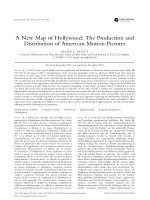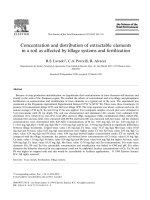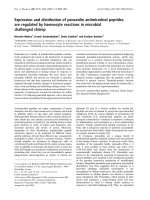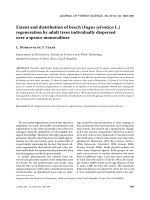Population abundance and distribution of ectoparasitic plant nematodes associated with apple trees (Malus domestica) in apple belts of Kashmir, India
Bạn đang xem bản rút gọn của tài liệu. Xem và tải ngay bản đầy đủ của tài liệu tại đây (310.55 KB, 8 trang )
Int.J.Curr.Microbiol.App.Sci (2018) 7(6): 3817-3824
International Journal of Current Microbiology and Applied Sciences
ISSN: 2319-7706 Volume 7 Number 06 (2018)
Journal homepage:
Original Research Article
/>
Population Abundance and Distribution of Ectoparasitic Plant Nematodes
Associated with Apple Trees (Malus domestica) in Apple Belts of
Kashmir, India
G. M. Lone*, F. A. Zaki, S. S. Pathania and Sajad Mohi
Department of Entomology, Faculty of Horticulture (S.K.U.A.S.T.-K), India
*Corresponding author
ABSTRACT
Keywords
Population Abundance,
Ectoparasitic Plant, Apple
Trees (Malus domestica)
Article Info
Accepted:
25 May 2018
Available Online:
10 June 2018
Fruits as a back bone of horticulture are grown over an area of 5.50 million hectares in our
country with a production of over 55 million metric tones per year. Our country accounts
for 10% of the total world production. Among various fruits, apple being the pre-dominant
temperate fruit of India accounts for about 3% of the total fruit production of the country.
India stands 8th in apple production in the world but ranks at 53rd position in terms of
productivity (FOA, 2007). In India average productivity of apple is nearly 6-8 tonnes per
hactare which is lower than the average yield of advanced countries. e.g. Belgium (46.22
tons/ha), Denmark (41.87) and Netherland (40.40 t/h). Among the temperate fruits in
Jammu and Kashmir, apple ranks 1st covering 43.30% area and 80.18 % production
respectively. (Anonymous, 2008). In the state, Kashmir valley is rich in flora and fauna
and it is the largest apple producing region in the country and at present apple industry has
become the backbone for Kashmir’s rural economy, generating employment to thousands
of people besides providing multinutrtional security.
Introduction
In Kashmir among the major districts viz
Baramullah, Shopian and Kupwara, the
Baramullah district ranks 1st in apple
production. Yield of apple has been showing
an increase trend from 4.12 to10.72 m tones
per ha during. (1975-2008) but the
productivity of apple in J& K fluctuated
between 9-11 M. T. or less since last sixteen
years (Banday, et al., 2009) which is the cause
of serious concern to the fruit growers,
research workers and development agencies.
Several factors are attributed to this trend in
productivity and among which incidence of
diseases and pests, in apple cultivation is
emerging as a serious threat to apple orchards
in the valley.
Among the various pests and diseases, the
information on nematodes parasitizing on
apple trees and their role in fruit damages is
scanty (Wali-ullah & Koul, 1989) and which
constitutes one of the most important group of
animals under a separate phylum Nematoda
and from which the class adenophorea,
includes
important
plant
ectoparasitic
nematodes, predisposing plants to many
fungal, bacterial diseases and as vectors of
several soil born plant viruses. becoming
3817
Int.J.Curr.Microbiol.App.Sci (2018) 7(6): 3817-3824
responsible for qualitative and quantitative
losses to fruits and the extend to which
knowledge in this field has advanced can be
judged from the reviews of Cadman (1963),
Pitcher (1965) and Bajaj and Jairajpuri (1979).
Due attentions has not been paid yet in the
valley and in view of paucity of information
regarding
their
frequency,
density,
prominanace value, systematic studies of these
plant parasitic adenophoreans associated with
important woody perennial fruit crops in
various fruit orchards of Rafiabad, the
important fruit belt of North Kashmir, was
essential to evolve economically feasible
control measures suiting to the local
conditions so that the much advocated lab to
land programme can become a practicability
in future and also to become a base line data
for further research work.
Materials and Methods
nematodes were heat relaxed, killed, fixed in
F: A (4; 1) and stored at 10-15°C for further
studies within a weeks period. The nematodes
were identified upto genus and species level
on the basis of morphological characters. and
absolute and relative density, frequency,
prominence value, importance value, biomass
and range of each adenophorean species was
determined (Norton, 1978) and diversion of
density index of adenophorean population was
also determined on the basis of population
abundance as follows.
No. of samples containing species/genus
Absolute
Frequency of sp./ genus X = -------------- x 100
No. of samples collected.
Frequency of species/ genus
Relative
Frequency of sp. / genus X = ------------- × 100
Sum of frequencies of all spp/ genus.
During summer (June, Jully and August,
2008) an extensive of plant parasitic
adenophoreans associated with apple trees was
conducted at nine fruit orchards in all three
villages (Ferozpora, Ladoora and Rebon) of
fruit belt Rafi-abad of North Kashmir. At each
location (Village) three fruit orchards having
almost same topography (Plains), same kind
and same aged apple trees were selected. From
each orchard three apple tree were selected at
random and one sample was collected from
each tree.
Present in samples
Thus a total of 27 samples were collected and
each mixed sample consisted of three sub
samples collected randomly away from the
base of 25 year apple trees within its
periphery. at 50 cm depth. Nematodes were
extracted from 250 cc soil sample by
cobb`sieving and decanding method (Cobb.
1918) using sieves of 18, 90, 150 & 200 mesh
followed by modified Baermann`s funnel
technique (Christie & Perry, 1951) The
Prominence value of sp. / genus X = Absolute
density √Frequency
No. of individuals of x in a sample
Absolute
Density of sp. / genus X = ---------------- × 100
Volume or mass or unit of sample.
No. of individuals of sp. / genus in a sample
Relative
Density of sp. / genus X = ---------------- × 100
Total no. of individuals of all spp/ genus. in a
Sample.
Biomass of sp. / genus x = a2.b / 16 × 105 µg.
(a = average greatest body width, b = average
body length of a nematode in µm)
Importance value = Relative frequency +
Relative density + Relative biomass
3818
Int.J.Curr.Microbiol.App.Sci (2018) 7(6): 3817-3824
The Shannon Weiner density index formula
was also applied.
Shannon`s diversity index (H) = ∑si=1 Pi In Pi,
where
s = number of species / genus at each location.
Pi = relative abundance of ith species / genus.
In=Natural Logarithum of n (Log with base e)
Results and Discussion
It is found that in 95% of taxonomically
identified adenophoreans, males were found
nowhere and so parthogenesis is assumed as
rule and according to the time limits of the
research programme, the species of only two
genera namely Xiphinema and Longidorus
were distinguished by morphological features
and among which some species are considered
as new report in Kashmir valley on apple trees
when others are already recorded. The results
revealed that more or less population of plant
parasitic adenophoreans were found associated
with apple trees in all the apple orchards of
each village in entire fruit belt of district North
Kashmir. Mixed population from the
composite soil samples comprised nine
populations (communities species wise) in
three groups. One group of adenophoreans
belong to subfamily- Xiphinematinae, familyXiphinematidae
of
super
family
Longidoroidea, Thorne, 1935 and orderDorylaimida This group includes four species
of genus Xiphinema viz. Xiphinama insigne;
X. index;
X americanum
and
X.
diversicaudatum. The other group of
adenophoreans
belong
to
sub-familyLongidorinae, family Longidoridae of same
super family Longidoroidea and order
Dorylaimida. It included three species of
genus Longidorus viz. Longidorus elongatus
s; L. mirus and L. brevicaudatus. The third
group belonged to a group of mixed
population named as other nematodes. It
included some tylenchids which could not be
excluded for the analysis of community
structure in the soil sample in total. during
extraction of adenophoreans by using some
selected sieve sets with few modifications.
This group also included some unidentified
adenophoreans and some nematodes of fungal
and bacterial feeders
Among the eight species of plant parasitic
adenophorean population of two genera
identified, maximum species are reported for
the first time from Kashmir and from India on
apple trees when some species are already
known from Kashmir and from rest parts of
India but on host other than apple trees.
Xiphinema insigne, Xiphinema index and
Longidorus
elongatus
were
found
predominant in orchards/ localities of entire
Rafi-abad fruit belt. Almost 100 % frequency
with leading population in abundance of each
of the three species was found in every fruit
orchard while the rest of the identified species
were also noted with more or less frequency
and population density. The diversity and
status of each species in detail is as under
Xiphinema insigne
100% frequency of occurrence of Xiphinema
insigne was found in each respective locality
viz Ferozpora, Ladoora and Rebon. Mean
population abundance of this species was
found as 92.56, 61.11 & 75.22 in localities
Ferozpora, Ladoora and Rebon respectively
with mean 76.03 in entire Rafi-abad ranging
from 69.15 to 83.45 at 95% confidence
interval and its relative frequency and relative
prominence value in the entire fruit belt in
comparison to other recorded adenophoreans
was found as 12.16% and 22.39%
respectively. (Table 1). Here highest absolute
population was found in the apple orchards of
Ferozpora (92.56) followed by Rebon (75.22)
and lowest in Ladoora (75.22).9Table 1). Its
3819
Int.J.Curr.Microbiol.App.Sci (2018) 7(6): 3817-3824
pathogenic significance rank on the basis of
prominence value (763.00) and importance
value (46.67) is second in the entire Rafi-abad
belt (Table 2) and on the basis of population
number the diversion of energy flow of the
adenophoreans was more in Rebon locality
(2.002) followed by Ferozpora (1.93) and
lowest in Ladoora (1.88) with overall
diversion in the belt as 1.97.
The presence of Xipheinema insigne showing
100% frequency with apple trees in all the
fruit orchards is in accordance of the results
recorded by Zaki and Manto (2003) during
their survey on apple orchards of Baramullah
and revealed 100% frequency with average
population per 250 cc soil ranging from 11145 whereas in our observation during the
peak season of July, 2008, the average
population per 250 cc soil was 69.84 ranging
from 66.17-73.51 at 95 % confidence interval.
This little fluctuation of the species with the
apple trees can be possible because of
involvement of different cultivars, age
differences in plants as our survey is based on
specific aged plants with homogenous
topography and specific depth of plant
rhizosphere in a particular season.
According to reports of H. K. Bajaj (1976), X.
insigne was recorded, having temperature
below 0 degree in winter while in other
regions it may rise to 40-45 °C during
summer, giving impression of higher tolerance
of species. In some samples, its population
constituted 90-95% of the total nematode
fauna, attacking usually fruit trees.
Heavy population of X insigne was also
reported by Baghel and Bhatti (1982) around
the routs of citrus fruits from Hissar, Haryana.
Lamberti, and Roca (1987) reported
distribution record of five most common
species of Xiphinema including X. insigne
around the roots of fruits crops in Pakistan.
Xiphinema index
The dagger nematode Xiphinema index was
found as second important dominant vector
after Xiphinema insigne on the basis of
pathogenic significane rank and also it was
found at par with Xiphinema insigne in
frequency (100%) in all the fruit orchards of
every locality (village) in Rafi-abad (Table 1).
The mean population abundance of Xiphinema
index in 250 c.c. soil around the apple trees in
Rafi-abad fruit belt was found as 72.69, 42.56
and 58.67 in Ferozpora, Ladoora and Rebon
respectively with mean in the entire fruit belt
as 58.04 ranging from 49.83 to 60.25 at 95%
confidence interval and with 100 % frequency
in the entire fruit belt of Rafi-abad. The
relative frequency and relative prominence
value in comparison to other plant parasitic
adenophoreans was found as 12.16% and
17.03% respectively (Table 2).
Looking over the status of Xiphinema index in
the fruit belt, its highest population was found
in the apple orchards of Ferozpora (72.89)
followed by Rebon (58.67) and lowest
population was recorded in Ladoora (42.56)
This species is cosmopolitan in woody plants
and is historically important because it was the
first nematode which was demonstrated to act
as vector of soil borne viruses by Hewitt et al.,
(1958) who proved that this species transmits
grapevine fan leaf virus
The X.index appearing in apple orchards
comprise actually the soil samples of
Mediterranean basin and which is considered
the distribution centre of X.index and
accordingly provides an explaination of our
results in relation to climate and potential
vegetation. This accords with the views of
Antoniou (1981) as the association of X.index
with soils of pH >7 and poor in organic
matter, which are generally the representative
of the Mediterranean area, seems logical.
3820
Int.J.Curr.Microbiol.App.Sci (2018) 7(6): 3817-3824
Table.1
Mean abundance, percent population, range and prominence value of plant parasitic adenophoreans associated with
apple trees in localities of Rafi-bad (North Kashmir).
Adenophorean Ferozpora(9)
Ladoora(9)
Rebon(9)
s
M.A. P.P.
95%.C. P.V.
M.A. P.P.
95%.C. P.V.
M.A. P.P.
95%.C. PV.
I.
I.
I.
92.56 27.04 79.65
925.6 61.11 20.11 52.78 – 611.1 75.22 18.98
65.41Xiphinema
752
105.47
69.44
85.03
insigne
.2
72.89 21.29 61.91 – 728.9 42.56 14.00 32.99 – 425.6 58.67 14.80
39.71X.index
586
83.87
52.13
77.63
.7
26.40
7.71
19.28 – 264.0 21.56
7.09
14.14 – 215.6 28.00
7.06
21.62X.americanum
280
33.52
28.98
34.38
.0
3.88
5.82 –
108.6 17.78
5.85
13.16 – 177.8 17.11
4.31
12.58X.divrsicaudatu 13.30
171
20.73
0
22.42
21.64
m
.1
14.30
4.17
3.89 –
95.29
8.33
2.74
5.32 –
73.46
8.44
2.12
4.01X.basiri
68.
24.71
11.34
12.87
91
29.40
8.58
15.07 – 277.1 26.89
8.85
16.45 – 253.5 41.67 10.51
29.43Longidorus
416
43.73
8
37.33
2
53.91
elongatus
.7
19.78
5.77
9.74 –
211.1 11.56
3.80
6.46 –
101.9 39.44
9.95
31.35L.mirus
394
29.52
9
16.66
5
47.53
.4
4.96
12.14 – 160.2 11.56
3.80
6.85 –
101.9 28.00
7.06
19.56L.brevicaudatus 17.00
280
21.86
8
16.27
5
36.44
.0
56.67 16.55
36.02566.7 102.4 33.72 92.06 – 1024. 99.78 25.17
85.17Other
997
77.32
4
112.82
4
114.39
nematodes
.8
H.
1.93,
1.884,
2.002
M.A=Mean abundance; P.P. =Percent population; C.I. =Confidence interval; P.V.=Prominance value;. H. =Shannon
wiener diversity index
Table.2
Community analysis of plant parasitic adenophoreans associated with apple trees in Rafi-abad (North Kashmir)
Adenophoreans spp
A.D.
95% C.I.
A.F.
A.B.
R.D.
R.F.
RB.
.PV
IV
76.30
69.15 – 83.45
100.0 128.1
21.95
12.16 12.5
763.0 46.
Xiphinema insigne
(1.88)
(1.84-1.92)
0
8
5
67
58.04
49.83 – 66.25
100.0 167.7
16.70
12.16 16.4
580.4 45.
X.index
(1.76)
(1.70-1.82)
0
4
2
28
25.32
21.61 – 29.03
100.0 67.35
7.29
12.16 6.59
253.2 26.
X.americanum
(1.40)
(1.33-1.46)
0
04
16.06
13.09 – 19.03
88.89 69.06
4.62
10.81 6.76
151.4 22.
X.divrsicaudatum
(1.20)
(1.12-1.28)
1
19
10.37
6.77 – 13.97
62.97 47.81
2.98
7.65
4.68
82.28 15.
X.basiri
(1.02)
(0.83-1.14)
31
32.67
25.92 – 39.42
92.59 183.9
19.40
11.28 18.0
314.3 38.
Longidorus elongatus
(1.51)
(1.41)
3
0
6
68
23.59
17.96 – 29.22
88.89 125.0
6.79
10.81 12.2
22.41 29.
L.mirus
(1.37)
(1.25-1.46)
3
4
84
18.85
14.91 – 22.79
88.89 43.73
5.42
10.81 4.28
177.7 20.
L.brevicaudatus
(1.27)
(1.17-1.36)
2
51
Other nematodes
86.30
(1.94)
75.59 – 97.01
(1.88-1.99)
100.0
0
188.1
3
24.83
12.16
18.4
2
863.0
55.
41
PSR
2
3
6
7
9
4
5
8
1
D.=Absolute density, C.I=confidence interval, R.D.=relative density, A.F.=absolute frequency. R.F.=relative
frequency, P.V.=prominence value, R.Pv=relative prominence value H.=Shannon weaver diversity density index,
I.V=Importance value, PSR=Pathogenic significance rank.
3821
Int.J.Curr.Microbiol.App.Sci (2018) 7(6): 3817-3824
Table.3
Mean abundance, percent population, density and diversity index of genus Xiphinema and Longidorus
vectors with apple trees in Rafi-abad (North Kashmir).
Genus
.Ferozpora
Ladoora
Rebon
M.A.
P.P.
M.A.
P.P.
M.A.
P.P.
219.45
64.11
151.34
49.82
187.44
Xiphinema
47.29
66.18
19.33
50.01
16.46
.109.11
Longidorus
27.53
1.83
1.89
H.
1.94
0.213
0.250
D.
0.161
35
35
% Moisture
35
1.2
0.98
Organic Carbon
1.2
7.1
7.0
SoilpH(1:2.5)
7.3
Soil type
Clay loam
Clay loam
Clay loam
H. =Shannon wiener diversity index, D=density, M.A=Mean abundance; P.P. =Percent population
And were also reported in potential
Mediterrnean orchards of apple and peach
trees with slightly acid soil in Region Central
(Spain) by Navas & Arias, 1986). As an
ecoparasite it reduces the growth of trees and
causes darkening of its roots (Cohn & Orion,
1970).
Longidorus elongatus
Longidorus elongatus was found as third
important adenophorean with its frequency 92
59% in the entire Rafi-abad. The mean
population abundance in the fruit orchards of
Ferozpora, Ladoora and Rebon was found
as29.40, 26.89 and 41.67 with its range in
each locality as 15.07 – 43.73, 16.45 – 37.33
and 29.43-53.91 at 95 % confidence interval
respectively (Table1). The prominence value
and importance value in Rafiabad fruit belt
were found as 314.36 and 38.68 respectively.
And similarly in entire Rafi-abad fruit belt the
mean population abundance was found as
32.67 with range of 25.92 – 39.42 at 95 %
confidence interval. Longidorus elongatus is a
root ectoparasite and aggregates around
growing roots (Whitehead and Hooper,
1970).Feeding at, or just behind root tips and
causes a characteristic swelling or galling and
a general stunting of the root system It
transmit the Scottish strains of raspberry ring
spot virus (RRV) (Taylor, 1962) and tomato
black ring virus (TBRV) (Harrison et al.,
1961).
Xiphinema americanum
The mean population abundance of this
species in the apple orchards of Ferozpora,
Ladoora and Rebon was found as 26.40,
21.56 and 28.00 ranging in each locality from
19.28-33.52, 14.14-28.98 and 21.62-34.39
respectively with over all mean population in
the entire belt as 25.32 ranging from 21.6129.03 at 95 % confidence interval. (TableT2)
and similarly the prominence value and
importance value of this species in the belt
was found as 253.2 and 26.04 respectively.
This species was already reported in very
heavy population from the roots of
ornamental plants at Nishat and Shalimar
gardens of Srinagar (Bajaj, H. K. 1976).
Xiphinema americanum is already reported by
Khan, M.L. and Anju S Khana. 1997 from
citrus trees of Himachal Pradesh.
Other species of Xiphinema
The mean abundance of Xiphinema
diversicaudatum in each locality (Ferozpora,
Ladoora and Rebon) was found as 13.30
(5.82-20.73), 17.78 (13.16-22.42) and 17.11
3822
Int.J.Curr.Microbiol.App.Sci (2018) 7(6): 3817-3824
(12.58-21.64) with over all mean abundance
16.06 (ranging from 13.09 to19.03) at 95 %
confidance interval. Its prominence value and
importance value in comparison to other
vectors in the belt was found as 151.41 and
22.19. And that of Xiphinema basiri it was
14.30(3.89024.71), 8.33 (5.32-11.34) and
8.44 (4.01-12.87) with over all mean
population abundance 10.37 (6.77-13.97) at
95 % confidance interval respectively (Table
1.). This species is already reported by Khan,
M.L. and Anju S Khana.1997 from citrus
trees of Himachal Pradesh and by Waliullah
and Koul in1997 from cherry trees of
Kashmir, India.
Other species of Longidorus
The mean population abundance of
Longidorus mirus in each locality was found
as 19.78 (9.74-29.52), 11.56 (6.46-16.66) and
39.44 (31.35-47.53) with over all mean
abundance in the belt as as 23.59 ranging
from 17.96 to 29.22 at 95 % confidence level.
Its prominence value and importance value in
the entire belt were recorded as 22.41 and
15.31 respectively. Similarly the mean
population
abundance
of
Longidorus
brevicaudatus in each locality were found as
17.00 (12.14-21.86), 11.56 (6.85-16.27) and
28.00 (19.56-36.44) respectively with its
overall mean abundance in the entire fruit belt
as 18.85 ranging from 14.91-22.79 at 95 %
confidence interval. Its prominence value and
importance value in the belt were recorded as
177.72 and 20.51 respectively.
Lamberti, et al., (1987) reported distribution
record of five most common species of
Xiphinema viz. X. basiri, X. brevicole, X.
index, X. insigne and X. intermedium around
the routs of fruits crops in Pakistan.
Viruses and their vectors have wide natural
host range and. Incidence of such vectors
depends on history of susceptible trees at a
site and which is evident in our research
programme because in all the apple localities
nematodes can be due to the long prevalence
or proximity of wild hosts in or nearby
orchards such as arable weeds, hedge-row
plants, other cultivable and wild fruit trees
like apricot cherry, pear, plum walnut etc and
willows, populous, other forest trees.
This data provides in detail and in a
systematic manner the means of forecasting
shadow of various dangerous plant parasitic
nematodes like Xiphinema insigne, Xiphinema
index and Longidorus elongatus, Xiphinema
basiri, Xiphinema americanum, Xiphinema
diversicaudatum and Longidorus mirus etc for
coming events of tomorrow due to global
warming as these vectors of viruses can give
much significance of pathogenic importance
besides other parasitic nematodes with the
rise of temperature in the soil
References
Anonymous. 2008. Area and production
statement for the
year 20072008.Department
of
Horticulture,
Jammu and Kashmir Govt.
Antoniou, M, 1981. “A nematological survey
of
vineyards
in
Cyprus”.
Nematol.medit.., 9: 133-137
Bajaj, H. K. and Jairajpuri, M. S. 1979.
Review of the genus Xiphinema Cobb
1913 with the description of species
from India. Records of the Zoological
survey of India 75: 255-325.
Bandy, F. A; Sharma, M. K; Pandith, A. H
and Bhat, M. Y. (2009).”Apple
production
in
Kashmir
valley:
challenges and opportunities. ”State
level seminar on “Fruit Industry of
Kashmir-Problems and Prospects”
Compendium” pp 11-22
Cadman, C. H. 1963. Biology of soil borne
viruses. Annual Review phytopathology,
1: 143 – 172.
3823
Int.J.Curr.Microbiol.App.Sci (2018) 7(6): 3817-3824
Chiristie, J. R. and Perry, V. G. 1951.
Removing nematodes from soil. Proc.
Helminth. Soc. Wash. 18: 106 – 108.
Cobb, N.A. 1918. Estimating the nemapopulation of soil with special reference
to sugarbeet and root-gall nemas
Heterodera schachtii Schmidt and
Haterodera radicicola (greef) Muller,
and
with
a
description
of
Tylencholaimus aequalis n. sp.
Cohn, E. and Orion, D.1970. The pathological
effect of representative Xiphinema and
Longidorus species on selected host
plant. Nematologica. 16: 423 – 428.
USDA Agriculture Technical circular
Bur. Pt. Ind. U. S. Dept. Agric. 1: 1 – 48
Harrison, B. D., Mowat, W.P & Tayler, C.E.
1961. Transmission of a strain of
tobacco black ring virus by Longidorus
elongatus (Nematoda). Virology. 14:
480-485
Hewitt, W. B., Raski, D. J. and Goheen, A. C.
1958. Nematode vector of soil – borne
fanleaf
virus
of
grape
vines.
Phytopathology. 48: 586 – 595
Lamberti, F. and Roca, F. 1987. Present status
of nematodes as vectors of plant
viruses. Pp 321 – 328 in vistas on
Nematology. (J. A. Veech and D. W.
Dickson, Eds) society of Nematologists,
Hyattsville, Maryland, 509p.
Mohd Luqman Khan and Anju S. Khana.
1997. Nematodes associated with Citrus
crops in Himachal Pradesh. Indian
Journal of Nematology 27(2): 266-67
Navas, A and Arias, M. (1986.) On the
distribution and ecology of Xiphinema
index and X italiae in Spain.
Nematol.medit.14:207-215
Norton, D. C. 1978. Ecology of plant parasitic
nematodes. John Wiley and Sons, Inc.
New York USA 263 pp.
Pitcher, R. S. 1965. Inter - relationships of
nematodes and other pathogens of
plants. Helminthological Abstracts
(Series B), 34: 1 – 17.
Taylor, C. E. 1962. Transmission of raspberry
ringspot virus by Longidorus elongatus
(deMan) (Nematoda; Dorylaimida).
Virology, 17:493-494.
Thorne, G.1935.Notes on free living and plant
parasitic nematodes. 11. In: Jairajpuri,
M.S. and Ahmad, W. (eds) Dorylaimida
Free living, Predaceous and Plant
parasitic nematodes. Oxford and IBH
Publishing Co. Ltd., New Delhi,
Mumbai and Kolkata, pp228-229
Waliullah, M. I. S. and Kaul. V. 1997
Nematodes associated with cherry
plants in Kashmir Valley India. Indian
Journal of Nematology 27: 237.
Whiteehead, A.G & Hooper, D.J. 1970.
Needle nematodes (Longidorus spp.)
and
stubby-root
nematodes
(Trichodorus spp.) harmful to sugar
beet and other field crops in England.
Ann.Appl.Biol, 65: 339-350.
Zaki, F. A. and Mantoo, M. A. 2003. Plant
parasitic nematodes associated with
temperate fruit crops in Kashmir valley,
India. Pest Management and Ecological
Zoology, 11(1): 97-101
How to cite this article:
Lone G. M., F. A. Zaki, S. S. Pathania and Sajad Mohi. 2018. Population Abundance and
Distribution of Ectoparasitic Plant Nematodes Associated with Apple Trees (Malus domestica)
in Apple Belts of Kashmir, India. Int.J.Curr.Microbiol.App.Sci. 7(06): 3817-3824.
doi: />
3824









